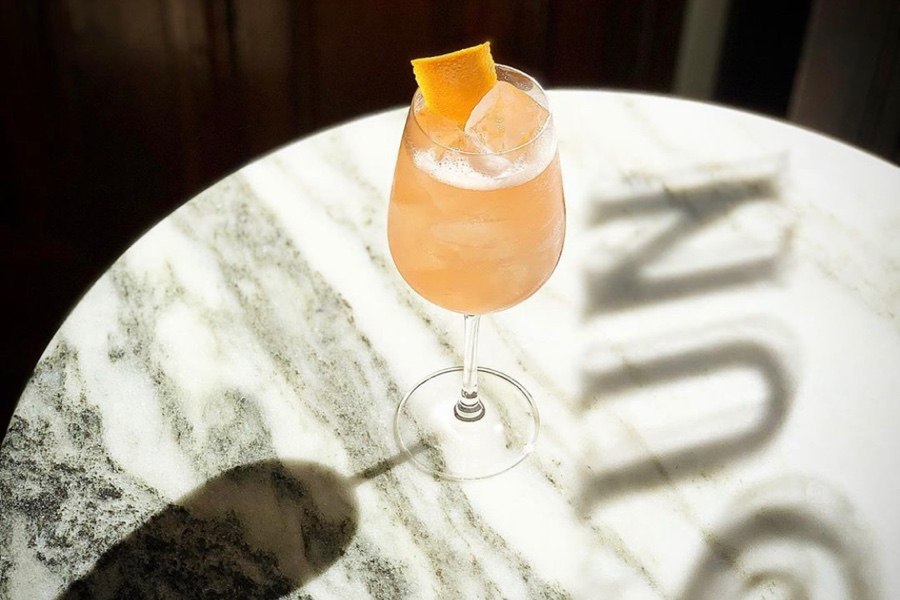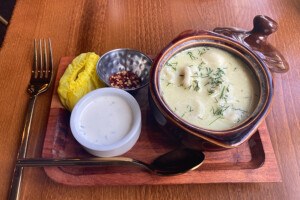A Philly Bartender Teaches You to Make Actually Good Drinks At Home
Paul MacDonald of Friday Saturday Sunday teaches the basics of home bartending.
The PLCB is still effectively shut down and bars are closed for the foreseeable future, but that doesn’t mean we’re not imbibing. You’re not alone if you find yourself missing your favorite cocktail, but just because you’re stuck at home doesn’t mean you can’t have a good, strong drink. And yes, you can still buy liquor in Pennsylvania. To help us better understand the art of mixing cocktails, we spoke with Paul MacDonald, head bartender at Friday Saturday Sunday. Here, he walks us through the basics.
The Tools and How to Fake Them
A two-piece metal shaker
The fake: a jar with a lid
Paul likes a 28-oz and 18-oz set, and prefers this over the 3-piece sets with a single cup, built in strainer and small lid. If you can’t get a shaker set, or don’t want to buy one, a glass jar with a lid is a perfectly fine replacement. The main thing that matters is that you’ve got a closed container in which you can vigorously shake your cocktail.
Hawthorne strainer, mesh strainer, and julep strainer
The fake: anything that will hold in the contents of the cup as you pour, or just pour the drink through a fine mesh strainer
A Hawthorne strainer fits into your shaker, while a julep strainer is more often used with a glass stirring beaker. Use a mesh strainer if you want a super-smooth cocktail with no pulp or ice crystals.
A glass stirring beaker
The fake: a glass measuring cup or pint glass
For stirred cocktails, Paul recommends using a glass stirring beaker or other glass cup, because it will dilute the drink slightly slower than a metal tin, giving the inexperienced home bartender a little more room for error. A dedicated beaker is helpful because it has a spout, but a pint glass also works well.
A bar spoon
The fake: a chopstick
Get something with a straight handle or a very gentle coil, otherwise the sharp corners of the coil will tear up your fingers as you stir. A chopstick is a good cheat here because it allows you to move the ice around the glass as one, without aerating the drink at all.
A pair of jiggers
The fake: a tablespoon
Paul prefers one jigger that measure 1 oz and 2 oz, and other that does 1/2 oz. and 3/4 oz. If you don’t have a jigger, you can measure out your drink with a tablespoon, which equals 1/2 oz.
A peeler
The fake: a sharp paring knife
“The Kuhn Rikon peeler is the only peeler anyone should own. I don’t even know why they make other peelers.” – Paul MacDonald
The Rules of Stirring, Shaking and Ice-Making
1. Drinks that include citrus, dairy or egg whites should be shaken, because they need to be aerated.
2. Those that include only spirits (think manhattans and martinis) should be stirred, which mixes the ingredients without aerating them.
3. Stirring and shaking serve to chill the drink, but they also serve to dilute the ingredients, which bring the flavors into proper balance. The amount of time this this takes can vary significantly depending on your equipment and ice, but a good rule of thumb is to keep shaking or stirring until your container is frosty on the outside.
4. For most cocktails, the volume of your poured liquor ingredients is between 3 and 3 1/2 ounces, and you want to add about 1 to 1 1/2 ounces of water through dilution. While there are exceptions to this rule, if you’re ending up with a drink that is more than 4 1/2 or 5 ounces, you might want to stir or shake for a little less time.
5. Smaller ice cubes will melt faster, diluting the drink more quickly, while larger cubes give you a little more time to stir or shake before hitting the point of over-dilution. While Paul emphasizes that you can make a good drink with any type of ice, investing in slightly better ice can help a beginner bartender by giving you a larger margin of error. If you’re interested in investing in better ice, Paul recommends Tovolo’s silicone trays, which make a cube similar to what you’ll find in a high-end cocktail bar. For serving, you can also check out their larger cubes, which fit perfectly into a rocks glass.
6. Keep in mind how you’ll serve the drink. A drink served up (with no ice in the glass) will want to be slightly more diluted than a drink served on the rock (with ice in the glass), since it will continue diluting as the drink sits.
What to Put In the Glass
“The obvious answer here is to get what you like,” Paul said. “The other end of the spectrum is to try to have everything so you can make almost any drink that someone might want. The middle of the road is to have about fifteen bottles that will allow you to combine them in a lot of different ways.”
Here’s what he recommends:
- Vodka
- A clear spirit, other than vodka (gin, white rum, blanco tequila)
- A dark spirit (whiskey, brandy, rum)
- A fruit liqueur (triple sec, St-Germain, creme de cassis)
- An amaro or bitter liqueur (Aperol, Campari, Averna, Nonino)
- Sweet vermouth
- Dry vermouth
- One type of aromatic bitters
The Templates
SHAKEN: The Basic Sour
- 2 oz. liquor
- 3/4 oz. citrus
- 3/4 oz. sweetener
“You can do this with your clear or dark spirits, or potentially even your amaro in the base. You can do it with simple syrup, or with your fruit liqueur as your sweetener.” This ratio makes drinks including the margarita or the whiskey sour.
STIRRED: The Martinez
- 2 oz liquor
- 1 oz vermouth
- dash bitters
“This is kind of the ancestor to the martini, the Manhattan, all those things. You can do it with any combination of clear or dark spirit and sweet or dry vermouth, with aromatic bitters, or with your amaro as an accent flavor. I also consider the Negroni to be a descendent of this ratio, so in that case, instead of adding bitters, you’re using a split base of liquor and bitter liqueur, but the flavor structurally works the same way as a classic Martinez.” For the record, a classic Negroni recipe is equal parts gin, Campari and sweet vermouth.



